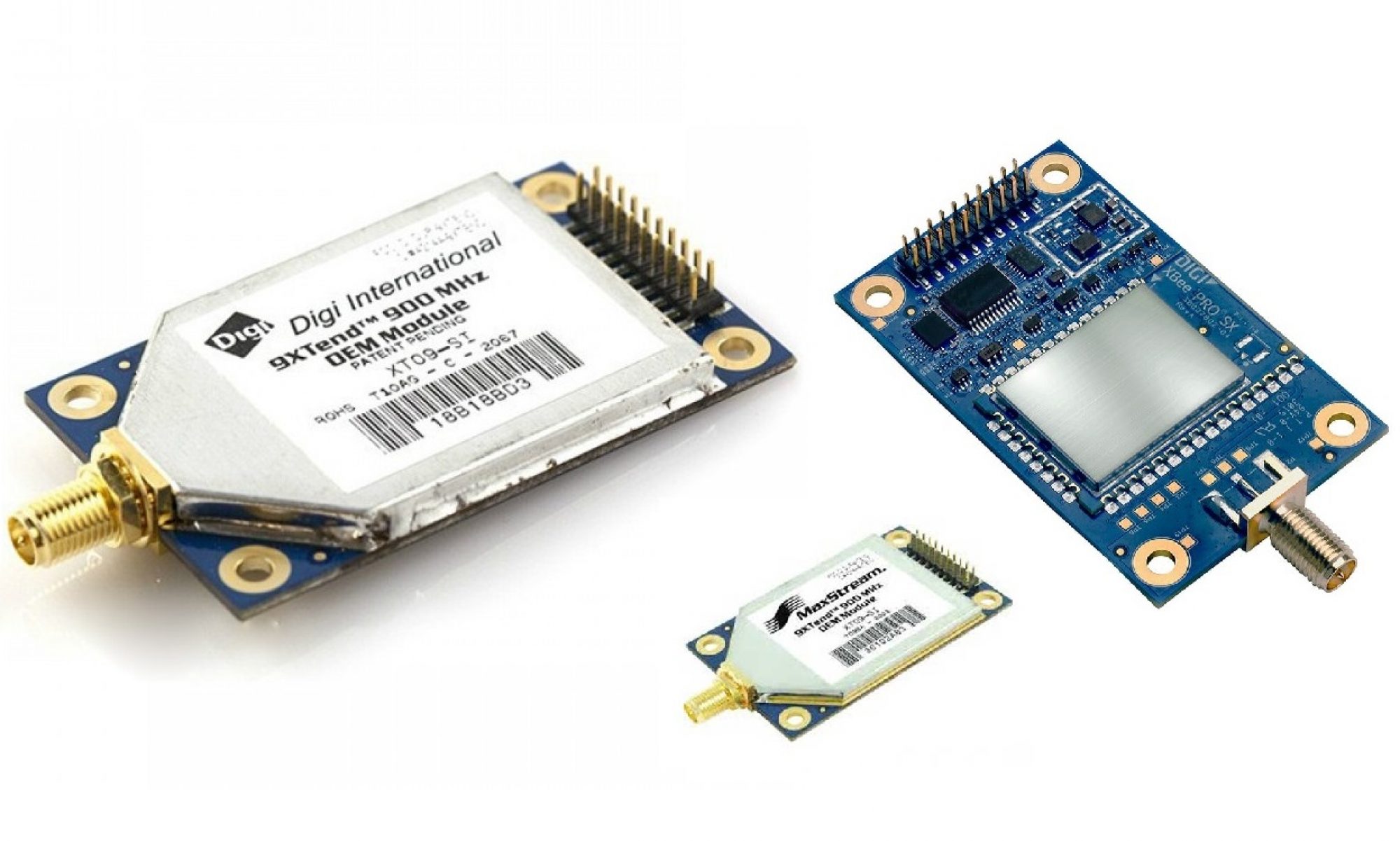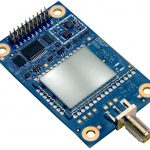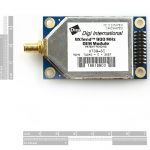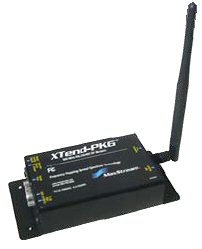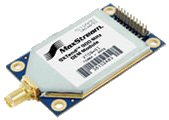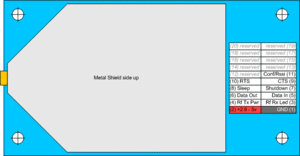ماژول XTend با توان یک وات RPSMA با برد ۴۰ مایل
توضیحات: ماژول XTend یک مودم رادیویی است که تعداد زیادی از امکانات و مشخصات پیشرفته را روی بوردی با ابعاد کوچک، توان پایین با کارکرد آسان و مطمئن مجتمع ساخته است. برد این ماژول در فضای باز و در حالت قرارگیری در خط دید یکدیگر حدود ۴۰ مایل و برد آن در محیطهای داخلی و سرپوشیده به ۳۰۰۰ فوت میرسد. این ماژول میتواند یک رشته داده سریال آسنکرون را ارسال نماید. باند کاری آن، باند ISM و در فرکانس ۹۰۰ مگاهرتز است. این ماژول قادر است دیتا را با ماکزیمم باودریت ۱۱۵٫۲kbps ارسال نماید. اتصال آنتن آن یک کانکتور RPSMA است.
Digi 9XTend
These larger units have been tested on the 900Mhz band, but are also available in 2.4Ghz. They are a bit on the heavy side, about 20 grams, but give good performance at range. They have adjustable transmit power settings from 100mW to 1W. Testing has shown range up to 5.6km (3.5 Miles) with XTend set to 100mW with small 3.1dB dipole antenna.
|
Pinout
| ۹XTend 20-pin Header | Name | Tiny Serial-1 Header | Notes |
| ۱ | GND | ۱ (GND) | Ground |
| ۲ | VCC | ۲ (۵V) | ۵V power (150mA – 730mA Supplied from servo bus or other 5V source) |
| ۵ | RX | ۸ (TX) | ۳-۵V TTL data input – connect to Tiny TX |
| ۶ | TX | ۷ (RX) | ۵V TTL data output – connect to Tiny RX |
| ۷ | Shutdown | ۲ | This pin must be connected to the 5V bus for normal operation |
Notes:
- ۹XTend can run on voltages as low as 2.8V but users are strongly advised against connecting any modem (especially high power models) to the sensitive 3.3V bus supplying the autopilot processor and sensors.
Documentation
Configuration
These modems need to be carefully configured based on your usage scenario to obtain the best possible range and link quality. In addition, it is always good to make sure the firmware is up to date.
Some typical configurations that may work well, but can still depend your particular situation, are given below. For further details, be sure to consult the XTend users manual. Your application may need a different or modified configuration. The radiomodems do not need identical settings and can in fact be optimized with different settings. A good example is delays and retries: if each radio has the same number of retries and no delay, when a collision occurs each will continuously try to re-transmit, locking up the transmission for some time with no resolution or successful packet delivery. Instead, it is best to set the module whose data should have a lower latency to have no delay and a lower number of retries, while the other module has a delay set (RN > 0) and a greater number of retries. See acknowledged mode example below.
- Acknowledged Polling Mode (Recommended):
- This causes one radio to be the base and the other(s) to be the remote(s). It eliminates collisions because remotes do not send data unless requested by the base. It can work in acknowledged mode (RR>0), basic reliable mode (MT>0) or in basic mode (no acknowledgement or multiple packets). It is recommended that the lower latency and/or higher data rate side be configured as the base (i.e. if you are sending lots of telemetry then the air module configured as the base is probably a good idea, but if you are using datalink joystick control, the ground side might be better as the base. It may require some experimentation).
- Acknowledged Point-to-(Multi)Point Mode:
- Each radio sends a packet and requests and acknowledgement that the packet was sent from the receiving side. The retries and delays must be set appropriately to ensure packet collisions are dealt with appropriately. It can also work without acknowledgements in basic reliable mode (MT>0) without any acknowledgements (RR=0, MT=0). Some experimentation may be required.
| Setting Name | Acknowledged Mode | Polling Mode (Acknowledged) | Notes | ||
| Airside Module | Groundside Module | Base Module | Remote Module | ||
| BD | ۶ | ۶ | ۶ | ۶ | Adjust to match your configured autopilot and ground station baud rates (default for these is 57600bps) |
| DT | default | default | ۰x02 | ۰x01 | Can be adjusted if consistency maintained across addressing functionalities (see manual) |
| MD | default | default | ۳ (۰x03) | ۴ (۰x04) | |
| MT | ۰ | ۰ | ۰ | ۰ | Use this to enable Basic Reliable transmission, link bandwidth requirement increases (see manual) |
| MY | default | default | ۰x01 | ۰x02 | Can be adjusted if consistency maintained across addressing functionalities (see manual) |
| PB | default | default | ۰x02 | default | Can be adjusted if consistency maintained across addressing functionalities (see manual) |
| PD | default | default | default | default | Can be adjusted to increase polling request rate and DI buffer flush timeout (see manual) |
| PE | default | default | ۰x02 | default | Can be adjusted if consistency maintained across addressing functionalities (see manual) |
| PL | default | default | default | default | Transmit power level should be reduced for lab testing!! |
| RN | ۰ (۰x00) | ۸ (۰x08) | default | default | |
| RR | ۶ (۰x06) | ۱۲ (۰x0C) | ۶ (۰x06) | ۱۲ (۰x0C) | |
Note: All settings are assumed to be default except those listed. Those listed are in decimal unless hex 0x prefix included. Depending on your firmware version, slight modifications may be necessary.
Here is some additional information and alternative instructions to configure the polling mode from the Digi site: Polling Mode for the 9XTend Radio Modem
ماژول XTend با توان یک وات RPSMA با برد ۴۰ مایل
توضیحات: ماژول XTend یک مودم رادیویی است که تعداد زیادی از امکانات و مشخصات پیشرفته را روی بوردی با ابعاد کوچک، توان پایین با کارکرد آسان و مطمئن مجتمع ساخته است. برد این ماژول در فضای باز و در حالت قرارگیری در خط دید یکدیگر حدود ۴۰ مایل و برد آن در محیطهای داخلی و سرپوشیده به ۳۰۰۰ فوت میرسد. این ماژول میتواند یک رشته داده سریال آسنکرون را ارسال نماید. باند کاری آن، باند ISM و در فرکانس ۹۰۰ مگاهرتز است. این ماژول قادر است دیتا را با ماکزیمم باودریت ۱۱۵٫۲kbps ارسال نماید. اتصال آنتن آن یک کانکتور RPSMA است.
ماژول XTend برای جلوگیری از تداخل فرکانسی با دیگر سیستمها از روش FHCC (پرش فرکانسی طیف گسترده) بهره میگیرد. بدین معنی که با ارسال هر بسته داده یا ارسال مجدد به فرکانس جدید پرش میکند. توان خروجی فرستنده ماژول را میتوان بصورت نرم افزاری بین ۱ میلی وات تا ۱ وات تنظیم کرد. توان ۱ وات بیشترین توان مجاز برای راه اندازی فرستنده های خصوصی در فرکانس ۹۰۰ مگاهرتز است.
برای ایجاد ارتباط رادیویی و تبادل داده به تنظیم یا کانفینگ خاصی نیاز نخواهد بود. تنظیمات پیش فرض یا default این ماژول دامنه وسیعی از کاربردهای سیستمهای داده را پشتیبانی میکند. برای اعمال تنظیمات پیشرفته میتوانید از دستورات کنترلی AT Command یا دستورات باینری استفاده کنید.
مشخصات:
ولتاژ تغذیه: ۲٫۸ تا ۵٫۵ ولت DC رگوله شده
باند فرکانسی: ۹۰۲ تا ۹۲۸ مگاهرتز
رابط داده سریال: رابط CMOS UART با سطوح ولتاژ ۳ تا ۵ ولت
جریان در ماکزیمم توان ارسال: ۷۳۰ میلی آمپر (با تغذیه ۵ ولت توان خروجی ۱ وات)
جریان در حالت دریافت داده: ۸۰ میلی آمپر (با تغذیه ۵ ولت و توان فرستنده ۱ وات)
برد مفید در محیطهای داخلی indoor و محیطهای شهری (با آنتن دیپل ۲٫۱dBi): تا ۳۰۰۰ فوت (۹۰۰ متر)
برد مفید در فضای آزاد در دید مستقیم (با آنتن گین بالا): تا ۴۰ مایل یا ۶۴ کیلومتر
توان خروجی فرستنده (با قابلیت تنظیم نرم افزاری): ۱ میلی وات تا ۱ وات (۰ تا ۳۰۰dBm)
ظرفیت ارسال داده (با قابلیت تنظیم نرم افزاری): ۹۶۰۰ بیت بر ثانیه یا ۱۱۵,۲۰۰ بیت بر ثانیه
کانکتور آنتن RPSMA
